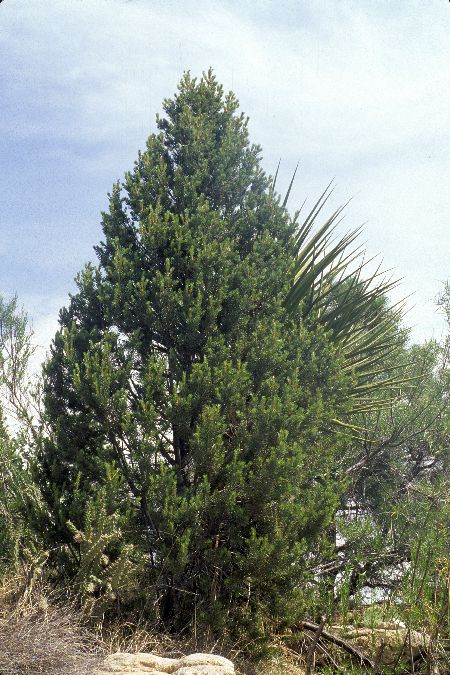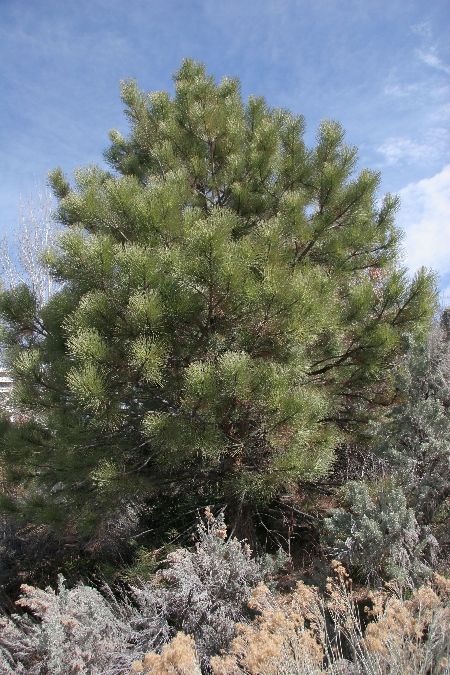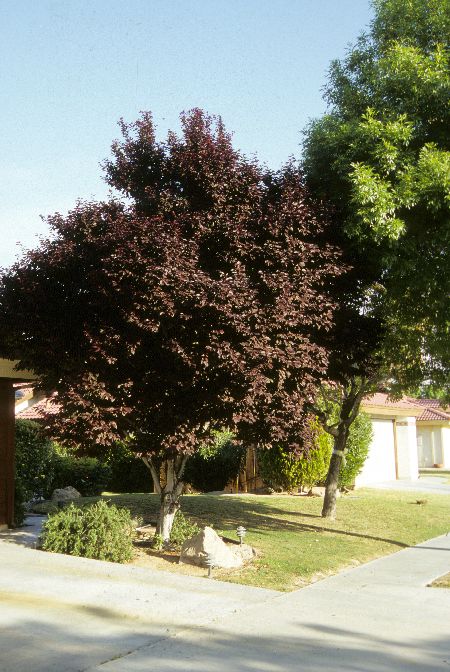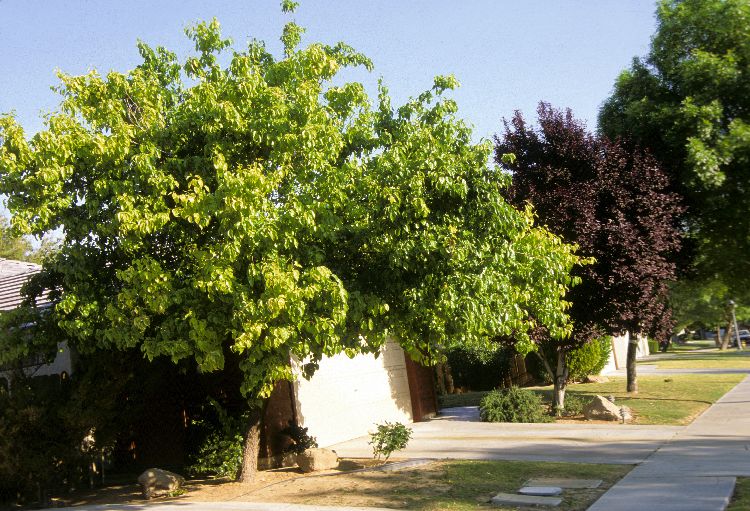Pinus bungeana
Lacebark Pine
Lacebark Pine grows as a rounded to pyramidal tree, often with multiple trunks. It makes an exceptional specimen pine, due to its interesting bark that flakes off in patches to reveal interesting puzzle pieces of gray, green and cream colors. Needles remain on the tree for several years. Small cones are yellowish brown. Canopy coverage: 707 square feet.
[Read More]Pinus densiflora
Japanese Red Pine, Tanyosho Pine
The form of Japanese Red Pine is irregular with a flat top, but it remains attractive. Orange-red bark is a striking feature. Blue-green needles change color in winter to a yellow-green or pale green. Accepts sandy to heavy clay soils, and poor soils. Canopy coverage: 491 square feet.
[Read More]Pinus densiflora 'Umbraculifera'
Tanyosho Pine
This selection is a dwarf version of Japanese Red Pine with a broad, umbrella shape. Blue-green needles change color in winter to a yellow-green or pale green. Bark is gray then turns orange-red with some age. Canopy coverage: 177 square feet.
[Read More]
Pinus edulis
Piñon Pine
Piñon Pine is a small stature tree but possesses much character. Slow growing, it takes several years before trees produce cones and edible seeds. It looks right at home in a rock or boulder garden. Canopy coverage: 177 square feet.
[Read More]Pinus flexilis
Limber Pine
Limber Pine is a desirable landscape tree. It has a pyramidal form when young that becomes broad with a rounded top at maturity. Branches may droop with age. Tolerates wind and poor rocky soils; avoid heavily irrigation. 'Vanderwolf's Pyramid' is an improved selection. Canopy coverage: 314 square feet.
[Read More]Pinus nigra
Austrian Pine
The overall appearance of Austrian Pine is similar to the popular Ponderosa Pine, with dense foliage and a pyramidal form that becomes more broad and flat-topped with age. A versatile tree, use it as a specimen, windbreak or screen. Best suited to irrigated landscapes. Accepts sandy to clay soils; prefers well-drained soils. Canopy coverage: 707 square feet.
[Read More]
Pinus ponderosa
Ponderosa Pine
Ponderosa Pine is a very popular and common evergreen. It has an upright, open, spreading form, so it is a tree for large spaces. Bark is distinctive orange-red to orange-brown that separates into large flaky plates. Accepts sandy to clay soils; prefers well-drained soils. Canopy coverage: 707 square feet.
[Read More]Pinus sylvestris
Scotch Pine
Young trees of Scotch Pine are conical then become open, round-topped and picturesque with age. Many improved selections are available. 'Fastigiata' produces a narrow, columnar form. 'Nana' is a dwarf form, to 8 feet high and as wide. (Shown, with distinctive orange-red bark.) Canopy coverage: 707 square feet.
[Read More]Platycladus orientalis
Oriental Arborvitae
This is a popular evergreen grown as a tree or shrub. The Oriental Arborvitae species produces an open, pyramidal habit. Soft, scalelike leaves present in flat, fanlike sections. 'Aurea Nana' features yellow-gold foliage, growing as a globe-shaped shrub to 5 feet high or more. Accepts sandy to heavy clay soils, as long as it is well drained. Canopy coverage: 177 square feet.
[Read More]Prunus armeniaca 'Sungold'
Apricot
This apricot is an early blooming tree, its flowers emerging even before leaves appear. Because flowers appear early in the spring season, they sometimes suffer from frost damage, reducing or eliminating fruit. Be aware it can be frustrating and challenging to grow them successfully. Many different fruiting selections available; check locally. 'Sungold' shown in photos. Canopy coverage: 79 square feet.
[Read More]Prunus avium
Bird Cherry
This Cherry is a parent to many Sweet Cherry cultivars grown for fruit production. It can be a bit problematic to grow successfully. Consider it mostly as an ornamental with fruit loved by birds and squirrels. The plant form is upright and rounded. Yellow fall color. If fruit is your goal, choose a selection adapted to your region, such as 'Stella', shown here. Canopy coverage: 314 square feet.
[Read More]
Prunus cerasifera 'Atropurpurea'
Purple Leaf Plum
Purple Leaf Plum is a small tree that remains in scale for residential use. Purple to bronze foliage contrasts nicely with green or gray-leaved plants. Canopy coverage: 177 square feet.
[Read More]Prunus maackii
Amur Chokecherry
Amur Chokecherry has a densely branched, rounded growth habit, and is one of the most cold hardy trees. Its most interesting feature is the rich, brown bark that sometimes peels away from the trunk. Yellow fall color. Accepts sandy to clay soils; prefers moist soils. Black berries adorn branches in midsummer. Canopy coverage: 314 square feet.
[Read More]Prunus nigra
Canadian Plum
Grows as a small, upright-branching tree. Pure white flowers blanket its branches before leaves emerge in spring. Considered one of the best pollinators to have on hand for hybrid, fruit-producing plums. Its fruit is also used to make jams and jellies. Enjoy striking red to purple fall color. Canopy coverage: 177 square feet.
[Read More]Prunus sargentii
Sargent Cherry
Sargent Cherry is one of the best ornamental cherries, growing with an upright, dense rounded crown. With time, it can become quite large—up to 50 feet or more. Deep pink flowers are profuse on the branches in early spring. Fall color is an attractive red. Mature purple-black cherries attract birds. Canopy coverage: 707 square feet.
[Read More]Prunus serrulata 'Kwanzan'
Kwanzan Japanese Flowering Cherry
The form of Kwanzan Japanese Flowering Cherry is an upside-down pyramid with stiff upright branches. Flowers appear in spring before or the same time as the leaves, which emerge as red and change to green. Early blooming habit can be an issue with cold temperatures. Accepts sandy to clay soils; prefers moist soils. Canopy coverage: 707 square feet.
[Read More]Prunus virginiana
Chokecherry
Chokecherry grows as a large shrub or tree. Leaves are dense on branches and emerge as green in spring then change to colorful reds and yellows. The fragrant white flowers are followed by small, dark red, edible fruit. Accepts sandy to clay soils; prefers moist soils. Canopy coverage: 314 square feet.
[Read More]Prunus virginiana 'Shubert'
Canada Red Chokecherry
Canada Red Chokecherry, also known as Shubert Chokecherry, grows in a pyramidal form. Leaves are dense on branches and emerge as green in spring then change rather quickly to purplish red. The showy white to pink flowers are followed by small, dark red, edible fruit. Accepts sandy to clay soils; prefers moist soils. Canopy coverage: 314 square feet.
[Read More]Pseudotsuga menziesii
Douglas Fir
Douglas Fir becomes a massive tree, producing a dense pyramid with horizontal branches. The mature height listed here is 80 feet, but trees in the wild are known to get much, much taller—over 250 feet. Commonly used as a Christmas tree. Accepts shearing to become a fine hedge. Accepts sandy to clay soils. Canopy coverage: 314 square feet.
[Read More]
Pyrus calleryana 'Bradford'
Bradford Pear
This dramatic flowering tree blooms early in spring, sometimes so early that freezes affect flowers. Additional cultivated varieties are available; check with local nurseries. Canopy coverage: 962 square feet.
[Read More]Quercus alba
White Oak
White Oak is one of the most admired and desired of all Oaks. Form is an open, rounded crown with heavy, wide-spreading branches. Leaves are pinkish when they emerge, changing to green then to red or purple in fall. Accepts loam to heavy clay soils, as long as it is well drained. Canopy coverage: 2,827 square feet.
[Read More]